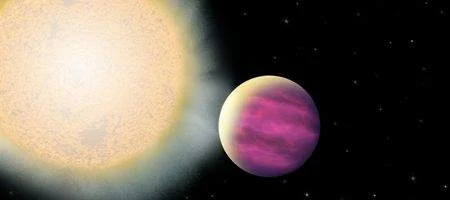Using a lens no more powerful than the one on your digital camera, astronomers have discovered two unusual exoplanets.

The KELT North telescope in southern Arizona is designed to scan large areas of the sky at low resolution – allowing it to observe stars that would simply be too bright for more powerful instruments.
And it’s now identified one massive, puffed-up planet that could change ideas of how solar systems evolve, along with another that orbits a very bright star.
KELT-1b, located in the constellation Andromeda, is so massive that it may better be described as a ‘failed star’ or brown dwarf, rather than a planet.
A super-hotball of metallic hydrogen that’s twice as dense as lead, it’s so close to its star that it orbits in just over a day, while being blasted by six thousand times the radiation Earth receives from the sun.
Intriguingly, the planet appears to have been jostled in the past by a previously unknown distant binary companion star that orbits the KELT-1 solar system.
In short, the planet “resets the bar for ‘weird’,” says Scott Gaudi, an associate professor of astronomy at Ohio State.
Likely because of the intense radiation, KELT-1b has inflated to a larger size than astronomers would normally predict.
“This is the first definitively ‘inflated’ brown dwarf found, and exactly how this happened is a complete mystery that should keep theorists busy for a while,” says Gaudi.
Astronomers are beginning to suspect that something unusual happens during the evolution of such solar systems to drive massive planets so close to their star. The presence of a stellar sibling orbiting both of the newly discovered solar systems may indicate that past interactions between the planets and these distant siblings is an important part of that process.
“We think they are born at much larger, colder distances, and then like retirees moving to Florida, they move to warmer climes as they get older,” says Gaudi.
The other planet, KELT-2Ab, is located in the constellation Auriga, and is typical of many previously discovered extrasolar planets in that it strongly resembles Jupiter. Its parent star, however, is very bright – so bright that astronomers believe that they will be able to directly observe KELT-2Ab’s atmosphere by studying the starlight that shines through it and the infrared heat that radiates from it, using telescopes located not only in space, but also on the ground.
“Normally, we would need a space telescope to do all that, but in this case the host star is so bright that we can make many of these measurements from the ground,” Beatty said.






